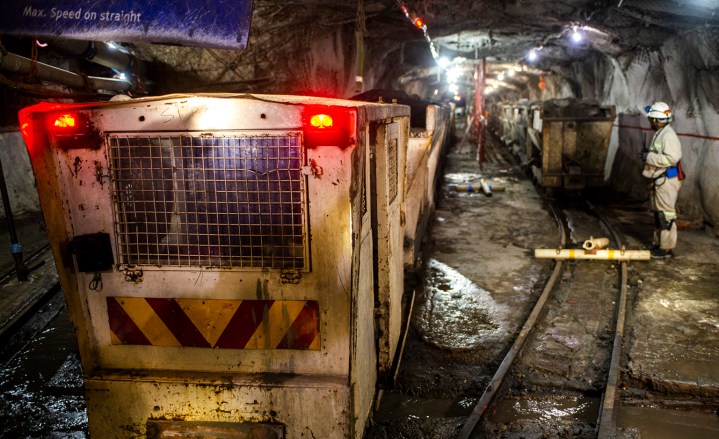ISS TODAY
South Africa can’t afford more delays on controlling the use of explosives

The police minister needs to fast-track explosives regulations to stop the illegal trade and safeguard the public.
First published in ISS Today.
At about 21:30 on 12 November 2020, an explosives truck was transporting around 20,925kg of commercial explosives. Between Delmas and Leandra in South Africa’s Mpumalanga province, the driver realised a rear tyre was on fire. He pulled over and warned oncoming traffic to move to safety.
The explosives detonated minutes later, causing a massive blast felt almost 100km away and leaving a crater several metres long and deep. Due to the driver’s swift action, no injuries or fatalities occurred.
Huge quantities of explosives are regularly transported on public roads in South Africa. That truck was one of many travelling every day to deliver its consignment to mines in the country. While the volumes being carried for legitimate business purposes present a controlled risk, a more worrying threat is the illegal movement of explosives in South Africa and the region.
The manufacturing, transportation, storage and use of explosives are regulated by three different acts and their accompanying regulations in South Africa: the Explosives Act 26 of 1956; the Mine Health and Safety Act of 1996, and the Occupational Health and Safety Act of 1993. Enforcing these laws is the responsibility of the South African Police Service (SAPS), Department of Mineral Resources, and Department of Employment and Labour.
The Explosives Act regulations cover the safe transport of commercial explosives. Licensed trucks must travel at night to avoid daytime traffic. Explosives must be carried according to their categories which means only compatible classes of explosives can be transported in the same vehicle. These rules aren’t followed when explosives are moved illegally, increasing the risk of accidental detonations.
Despite the average annual consumption of 300 million tons of commercial explosives in the country, the safety record is relatively clean. Nonetheless, the risks of transporting explosives are real and accidents can happen, as happened in the case above.
Organised criminal networks use illegal explosives in crimes such as cash-in-transit heists, ATM bombings and illegal mining, providing a great return on investment for all involved. According to the latest police crime figures, there were 64 cash-in-transit robberies nationally from July to September 2020 – a 60% increase from the same period in 2019.
The arrest of a truck driver smuggling illegal explosives at the Beitbridge border post with Zimbabwe in November 2020 further exemplifies the problem. Police discovered 115 blasting cartridges and 100 connector capped fuses on the truck in blatant violation of the regulation on transporting dangerous goods. According to international guidelines, the two classes of explosives weren’t meant to be carried in the same vehicle.
The explosives had been stolen from a neighbouring country with the intention of smuggling the cargo into South Africa. These actions by criminal syndicates endanger the truck drivers, police, customs officials, other road users and the public.
The unsafe transportation, storage and use of explosives by criminals is a disaster waiting to happen. Yet for organised crime groups, it’s just another way to make profits at the expense of public safety.
Aside from the money to be made, explosives smuggling is a viable option due to the lack of effective legislation governing the transport, storage and use of explosives in the southern Africa region. The lack of harmonised laws between Southern African Development Community (SADC) countries is also an issue, along with poor communication and information sharing between law enforcement officers from various countries.
There are several steps to tackling the problem, starting with the SAPS – the leading regulator controlling explosives in South Africa. The police are using an outdated act and the police minister should sign and promote the new explosives regulations. Although the Explosives Act was approved by the president in 2003, it is yet to come into operation. This presents a major problem for law enforcement.
A platform should be established to allow Chief Inspectors of Explosives and those responsible for the control of explosives to share information, relay new developments in the SADC region and form common practices to facilitate their work.
Where necessary, countries must update their laws and regulations in line with global standards and implement lessons on combating explosives smuggling and improving the safe transportation of legal explosives. This will provide a foundation for a strong regional response in SADC states.
South Africa needs a framework for tracking explosives, including the unique marking of each item so it can be traced back to its original owner or user. To curb the smuggling of explosives and firearms into the country, task teams comprising explosives, K9, revenue services and border control officials are needed to conduct operations at ports of entry.
SADC is a resource-rich region. This means explosives will continue to be used in mines and for other commercial purposes, and the problem of illegal explosives smuggling will persist. The risk of explosions can’t be eradicated. But better legislation and information sharing can make the transportation of legal explosives safer and help reduce their illegal trade. DM
Richard Chelin, researcher and Willem Els, senior training coordinator, Institute for Security Studies, Pretoria.




















 Become an Insider
Become an Insider
For the sake of the many very dedicated members of the South African civil service and the formal explosives industry, I recommend you contact Nixt.co.za for an independent response to this article.
OMW , I just travelled back in time .
+- 46 years !
The explosive truck had delivered to Libanon Gold Mine , travelling along the dual carriageway towards the 4 way stop . Of back then the Jhb /Potch road and the Randfontien /Fochville intersection .
To deliver to the then ‘Kloof’ GM .
It never made it !
The story is eerily similar , Westonaria was now in the distance .
In those days there was a guard with a red flag sitting on the back .
Unknown to him , a tyre had caught fire , fortunately a passing driver alerted the truck driver .
The driver and guard fled on foot , as the truck went skywards .
Such news traveled fast , before ‘social media ‘ .
That said there were not many people at the scene by the time I arrived .
And no sign of the truck !
Apparently , the largest piece found , was 2-3 lobes of the crankshaft , over 100 m away from the blast .
‘Ground zero ‘ was epic !
The crater was well over 50 m in diameter and a good 20 m in depth !
The photo I took of a friend in the middle is lost to history 🙁
Westonaria , took the brunt of the blast , many shop windows being blown in .
It was felt in Potch , some 50? kms away .
Sometime in the late 70s/ early 80s , the Zambians topped us by far .
The name’ Kaffironda ‘ comes to mind , yes , this was Zambia . I think that was the manufacturing company ?
They relied on rail transport .
Some time after leaving the depot , apparently …there was friction between a carriage and a wheel .
This was not some truck supplying a couple of mines .
This was the supply to the Copperbelt . Am unaware of the number of carriages , could have been 20-30 .
Was a chain reaction as carriage after carriage exploded .
The resulting shortage of explosives stopped production for some time .
Moving on and back 🙂
Having been out of the mines for over 40 years , have no idea of the current ‘safety ‘/security measures in place on the mines .
An explosive truck would arrive at your level with around 50 x 25 kg boxes of explosives . then delivered to your section and stored 50kgs at a time , I forget the distance apart , 25 m ? I guess .
The fuses /blasting caps / ignitor cord /delay starters were collected daily by the miner .
Carried by his assistant in a locked bag to the work place .
It was a ‘one key fits all’ setup , literally !
Early in ’75 some miners from Randfontein Estates , sold some explosives to some Swazi dissidents .
Who then blew up a few electricity pylons in their country .
Not sure of the type of explosives used .
Special branch did not tell me more .
That is another story 🙂
Back then , blasting cartridges were 32×200 mm ammo dynamite and 20×100 mm gelignite . Used in wet areas . The basic ammonium nitrate was 4 bags/25 kg box .
The problem with the cartridges was they had a limited ‘shelf life’ underground . Going mushy and highly impact sensitive .If just dumped in the full orepass resulted in an explosion , severely injuring the boiler maker working above as the red hot metal ignited said explosive . If frozen , the same applied , there was a warning of that possibility at the shaft head . The gelignite was impact sensitive , regardless of the temperature . One small stick hit with a 14 lb hammer would crack a 1.2x 1.2 rock that was affecting production . Obviously done from behind the shelter of a wooden ‘pack’ , a ‘jarring ‘ to the hand and arm was temporary . The hammer was scrap !
Unless every worker is screened/search on exit from the mine , theft is possible .
Just 3-4 sticks , can do serious damage .
However , if said explosive is ‘covered ‘ , by mud in a mining application , the explosive force is greatly magnified !
The 2003 Explosives act was signed into law replacing the 1956 act. Industry is using it and are referring to it.
How it it possible the police are ignoring it and still only using the old 1956 law as this article implies?